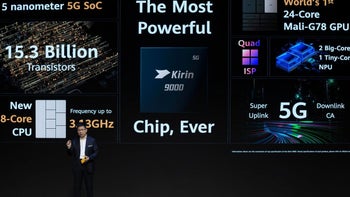Huawei's 2020 Kirin 9000 outperforms the new Kirin 9000s in head-to-head battle

Back in May 2020, the U.S. Commerce Department changed U.S. export rules so that foundries producing chips with American technology would be banned from shipping cutting-edge silicon to Huawei. This forced Huawei to offer 4G phones like 2022's P50 and Mate 50 series and 2023's P60 line before shocking the world last August. That is when the beleaguered manufacturer introduced the Mate 60 series powered by a 7nm Kirin 9000s 5G chip built by China's largest foundry SMIC.
We may never know how Huawei was able to pull this off considering the sanctions and the company's placement on the entity list along with SMIC. This prevents both firms from accessing their U.S. supply chain without obtaining a license. But various benchmark tests run on the 7nm Kirin 9000s and the previous chip that Huawei used for the Mate 40 series, the 5nm Kirin 9000 (which also is a 5G chip), reveal that the older chipset is a better component overall than the newer chipset.
The 2020 Kirin 9000 SoC delivers much better graphics than the 2023 Kirin 9000s
Nanoreview.net (via Tom'sHardware) recently put devices powered by both chips through different benchmark tests and discovered that while the CPU performance was slightly improved on the newer Kirin 9000s, the Kirin 9000 had higher scores on other tests. On Geekbench 6, the new SoC had a single-core score of 1315 and a multi-core score of 4078 compared to the 1259 single-core and 3486 multi-core scores tallied by the 2020 Kirin 9000.
On AnTuTu 10, both application processors fared similarly with the Kirin 9000s barely beating out the Kirin 9000 by a score of 897,496 to 894,530. But one area where the new chip fell short by a fairly large margin was with the GPU tally where the new chip scored 200,982 compared to the higher 315,801 put up by the older chip. The GPU on the higher-scoring Kirin 9000 was the 24-core Mali-G78. The newer Kirin 9000s uses a four-core Maleoon-910 and delivers GPU performance in line with 2020's Snapdragon 888 which used the Adreno 660 GPU.
Speaking of graphics, on 3DMark Wild Life the 2020 chip was 20% faster than the 2023 chip. And in a no-brainer, the older chip was more energy-efficient than the newer one. That could largely be due to the process node used to build the two SoCs with the Kirin 9000 manufactured by TSMC using its 5nm node and the Kirin 9000s produced by SMIC using its second-generation 7nm node.
Huawei and SMIC can only do so much with the deep ultraviolet lithography (DUV) machine that they are allowed to import. To get under 7nm, the pair might have to check out Cannon's nanoimprint lithography (NIL) technology that it announced back in October. That tech can be used to make 5nm chips and possibly 2nm in the future. The extreme ultraviolet lithography (EUV) machines used on today's cutting-edge chips are banned from getting shipped to Chinese companies.
A more concerning development could take place soon based on last year's patent applications filed by Huawei
Lithography machines are used to etch circuitry patterns on silicon wafers that are then sliced into individual dies. With billions of transistors inside chips, the EUV machines are vital because they can etch lines thinner than a human hair on the wafers allowing more powerful and energy-efficient chips to be built. One possible worry for U.S. officials is that about a year ago, Huawei reportedly filed patent applications covering EUV components and the process of using the technology.
There is no indication that any of the tech mentioned in the patent application filing was used by SMIC to make the Kirin 9000s. But if Huawei is able to develop its own cutting-edge lithography technology that escapes the reach of U.S. sanctions, it will be much more surprising and concerning for U.S. lawmakers.
Besides the smaller transistors used on the 2020 Kirin 9000 compared to the Kirin 9000s, the CPU cores on the older chip have a clock speed up to 19% faster (3.13GHz vs. 2.62GHz) and better instruction set architecture.










Things that are NOT allowed: